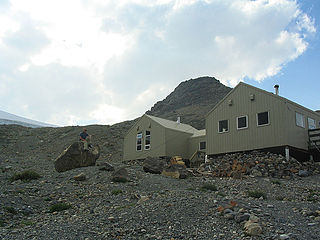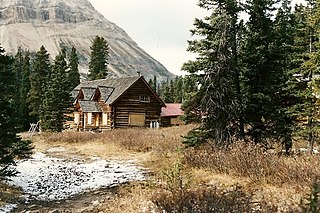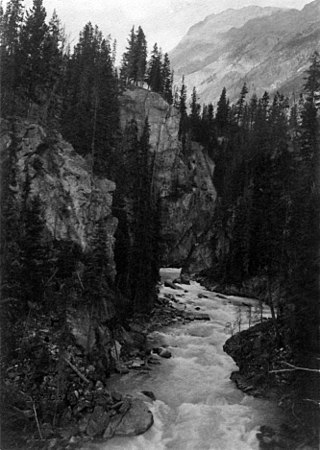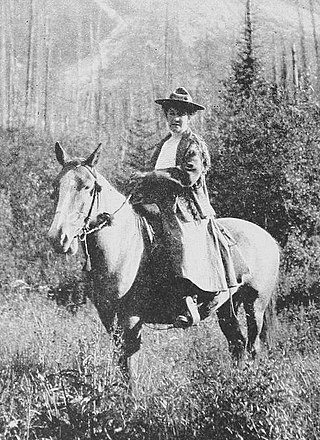
Banff National Park is Canada's oldest national park, established in 1885 as Rocky Mountains Park. Located in Alberta's Rocky Mountains, 110–180 kilometres (68–112 mi) west of Calgary, Banff encompasses 6,641 square kilometres (2,564 sq mi) of mountainous terrain, with many glaciers and ice fields, dense coniferous forest, and alpine landscapes. Provincial forests and Yoho National Park are neighbours to the west, while Kootenay National Park is located to the south and Kananaskis Country to the southeast. The main commercial centre of the park is the town of Banff, in the Bow River valley.

The Canadian Rocky Mountain Parks World Heritage Site consists of seven contiguous parks including four national parks and three British Columbia provincial parks.

Banff Sunshine Village is a ski resort in western Canada, located on the Continental Divide of the Canadian Rockies within Banff National Park in Alberta and Mount Assiniboine Provincial Park in British Columbia. It is one of three major ski resorts located in the Banff National Park. Because of its location straddling the Continental Divide, Sunshine receives more snow than the neighbouring ski resorts. The Sunshine base area is located 15 km (9 mi) southwest of the town of Banff. By car, it is about a ninety-minute drive from the city of Calgary; the Sunshine exit on the Trans Canada Highway is 8 km (5 mi) west of the town of Banff.

Peyto Peak is a mountain in the Waputik Range, part of the Canadian Rockies in Alberta, Canada. It lies at the north end of the Wapta Icefield, in Banff National Park, about one km (0.6 mi) east of the border with British Columbia and 32 km (20 mi) north of the town of Field. Five kilometres to the northeast lies Bow Pass, one of the high points of the Icefields Parkway. Between the peak and the pass lies picturesque Peyto Lake. Three kilometres southwest of Peyto Peak is Mount Baker, the highest point in the immediate vicinity.

The Wapta Icefield is a series of glaciers located on the Continental Divide in the Waputik Mountains of the Canadian Rockies, in the provinces of British Columbia and Alberta, in Yoho National Park in the Canadian Rockies. The icefield is shared by Banff and Yoho National Parks and numerous outlet glaciers extend from the icefield, including the Vulture, Bow and Peyto Glaciers. Runoff from the icefields and outlet glaciers supply water to both the Kicking Horse and Bow Rivers, as well as numerous streams and lakes.

Johann Wolfgang "Hans" Gmoser, CM was a founder of modern mountaineering in Canada. Born in Austria in 1932, he came to Canada in 1951, and was a major driving force behind the growing popularity of climbing, skiing and guiding.

Tunnel Mountain, also known as Sleeping Buffalo, is a mountain located in the Bow River Valley of Banff National Park in Alberta, Canada at the junction of the Spray River with the Bow and overlooking the Hot Springs on Sulphur Mountain. The mountain is nearly completely encircled by the town of Banff and the Banff Springs Hotel grounds. For many Indigenous people, the Buffalo is not sleeping anymore since Banff National Park reintroduced wild bison in 2017.

Peter and Catharine Whyte were twentieth-century Canadian artists from Banff, Alberta known for their landscape paintings of the Canadian Rockies. Their paintings and extensive collection of regional artifacts formed the genesis of what would later become the Whyte Museum of the Canadian Rockies. The Alpine Club of Canada dedicated the Peter and Catharine Whyte Hut on the Peyto Glacier after the couple.

Carl Clemens Moritz Rungius was a leading American wildlife artist. He was born in Germany though he immigrated to the United States and he spent his career painting in the western United States and Canada. Active primarily in the first half of the 20th century, he earned a reputation as the most important big game painter and the first career wildlife artist in North America.

The Bow Hut is an alpine hut located at an elevation of 2,350 metres (7,710 ft) on the eastern edge of the Wapta Icefield in Banff National Park. It is the largest, best equipped, and most accessible of the four alpine huts on the Wapta Icefield, and serves as the base for a wide variety of ski tours and mountaineering ascents to half a dozen peaks on the Wapta. It is the easiest and safest starting point for the Wapta traverse; and Balfour Hut, the next hut on the traverse, can easily be reached from it in a day. It can also serve as an intermediate stop in a longer traverse which starts at the less easily accessible Peyto Hut. The hut is maintained by the Alpine Club of Canada.

Norman K. Luxton was a pioneer in the Canadian Rockies known as "Mr. Banff". With John Voss, he attempted to sail around the world in an old red cedar Indian dug-out canoe. On his return to Canada, he worked on improving the community of Banff, Alberta and the relationship between its residents and the aboriginal community.

The Skoki Ski Lodge National Historic Site of Canada was built in 1930-31 in the Skoki Valley of Canada's Banff National Park. Built by local members of the Ski Club of the Canadian Rockies, the lodge was the first commercial building built specifically to serve skiers in Canada, and possibly in North America. Design and construction work was carried out by local outfitter and builder Earl Spencer with help from Spud White and Victor Kutschera. The lodge was progressively expanded through 1936 by outfitter, guide and log home builder Jim Boyce who was also managing the Lodge the time. It has remained unaltered since that time. The Lodge operates throughout the year.

Ebenezer William Peyto was an English-Canadian pioneer, mountain guide, and early park warden of Banff National Park.

Nora Drummond (1862-1949), also known as Norah Drummond and Norah Drummond-Davies, was an English, and later Canadian, artist and illustrator, whose work typically featured dogs and country pursuits.

Byron Hill Harmon (1876–1942) was a pioneering photographer of the Canadian Rockies. Harmon was born in Tacoma, Washington. Prior to his move to Canada, Harmon got his start in photography as the proprietor of a photographic supply store in Washington State, where his employees included future dance photographer Wayne Albee.

Thomas Edmonds Wilson was a Canadian outfitter and guide.

Mary Schäffer Warren (1861–1939) was an American-Canadian naturalist, illustrator, photographer, and writer. She was known for her experiences in the Canadian Rockies in the early 20th century.

Mount Jimmy Simpson is a 2,966-metre (9,731-foot) summit located 3 kilometres northwest of Bow Lake in Banff National Park, in the Canadian Rockies of Alberta, Canada. Its nearest higher peak is Mount Thompson, 3.0 km (1.9 mi) to the southwest. Mount Jimmy Simpson is a member of the Waputik Mountains, and is situated east of the Wapta Icefield and west of the Bow River valley. Mount Jimmy Simpson can be seen from the Icefields Parkway at Bow Lake. Jimmy Simpson Junior is a 2,721 meter sub-summit east of the mountain.
Dulcie Foo Fat is a British-born Canadian landscape painter, based in Calgary, Alberta.
Jon Whyte was a Canadian poet, curator and non-fiction writer in Banff, Alberta. He believed poetry was a "public act" and that it informs and educates in a way almost no other medium can. He was an advocate for the Canadian West and specifically the Rockies in both poetry, non-fiction, and his activities as a conservationist. Even today, his name is considered by many to be synonymous with the Canadian Rockies.
Unless specifically stated otherwise, the sources for this article are the Whyte Museum website and their online archives.


























